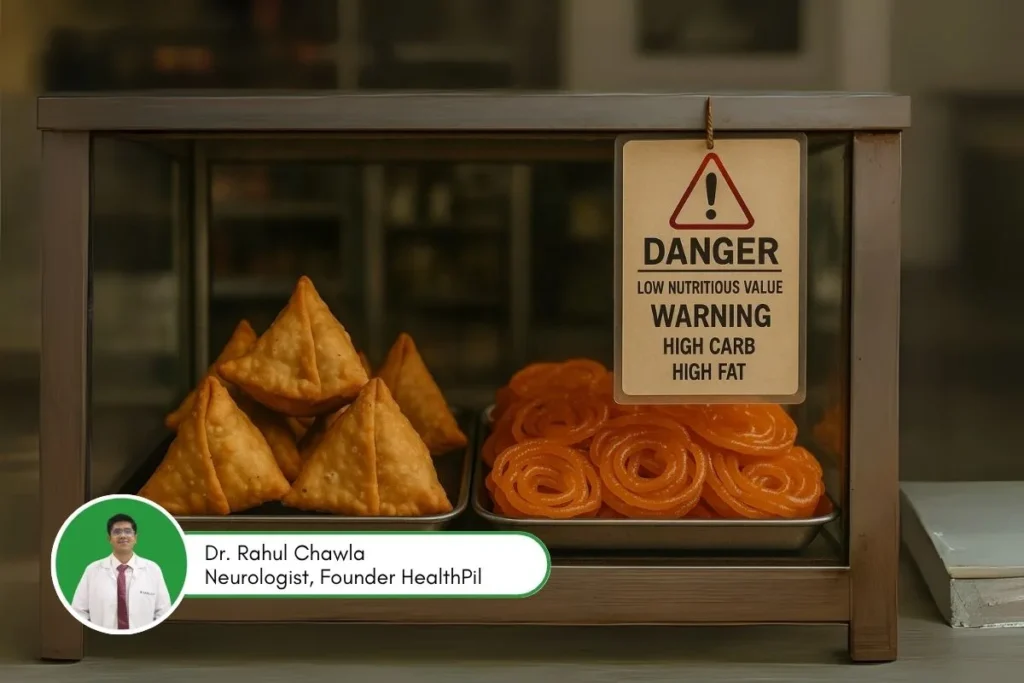The Health Ministry recently issued an advisory asking institutions to display information boards highlighting the oil and sugar content of commonly consumed foods. This move was widely misinterpreted online as an order to label samosas and jalebis with statutory warnings. But let’s get this part clear, there is no directive asking for warning labels on samosas, jalebis, laddoos, or any other specific Indian food. The recommendation is simply to install “oil and sugar boards” to make people more aware of hidden fats and sugars in everyday snacks.
Even though the idea of nudging people toward better choices is valid, the bigger question still remains — are healthier alternatives even available?
I spent fourteen years across multiple medical colleges from MBBS to MD to DM, and in all those years, through different campuses, institutions, and postings, there wasn’t a single evening when I could walk into a hospital canteen or a hostel mess and find a clean, affordable, nutritious snack. The options were always a cold samosa that had been refried two or three times in stale oil, instant noodles, a bread omelette or a sugary tea with glucose biscuits. That was the extent of what was offered to students, residents, staff, and patients alike. Over the years, I repeatedly asked canteen operators and mess staff whether they could introduce something simple and nourishing. I wasn’t demanding quinoa or avocado toast, just something basic, and practical things like idli-sambhar, poha, roasted chana, boiled eggs. I received the same answer in every place: “Sir, demand nahi hai.”

In most places now-a-days, the oil used for frying is rarely discarded after a single cycle. It is reused up to five or six times, sometimes even over days, and stored in questionable conditions. When oil is reheated repeatedly, it breaks down into toxic compounds like aldehydes and trans fats, which are strongly associated with increased risks of cardiovascular disease, fatty liver, insulin resistance, and even certain cancers. The oil used is often palm oil, because it is cheap, widely available, and doesn’t go rancid quickly. But palm oil is high in saturated fat and promotes inflammation in the body, especially when it is refined or repeatedly heated. It increases LDL cholesterol, affects endothelial function, and has been linked with a higher risk of metabolic syndrome.
The milk you get these days is made by mixing milk powder, detergent, and starch. The paneer is commonly prepared with industrial whiteners or synthetic milk, and the khoya used in sweets is sometimes adulterated with refined flour and starch to increase volume. Yet, these are the ingredients that people eat on a daily basis and none of these items carry warnings.
At the same time, the products that claim to be “healthy” are no better. Biscuits labelled as “high fibre,” cereals with “no added sugar,” or so-called “diet snacks” often contain hidden sugars like jaggery syrup, date extract, or fructose which all act as glucose in the body and contribute to the same spike in blood sugar.
Meanwhile, India’s health indicators are deteriorating. As per ICMR-NIN 2023 data, more than 135 million people in India are obese. According to WHO estimates, childhood and adolescent obesity in India has reached 13.9% in urban areas. The NFHS-5 data shows a sharp increase in overweight and obesity rates in both men and women over the last five years.
The solution is not to put a warning. It is to ensure that when a person enters a canteen, they are offered something better as well, not priced higher, but placed right next to the fried snack as an alternative.
We need a policy that mandates at least one healthy, protein-rich, affordable food item in every institutional menu. We need regulations on oil reuse, sourcing ingredients, and food hygiene.
So what do you think? Will oil and sugar boards on processed food really change the way people eat, or is it time the government worked on creating policies that improve food quality, regulate ingredients, and ensure that healthier choices are made available?
We’d like to hear your thoughts. What’s served in your college, hospital, or office canteens?
Frequently Asked Questions (FAQs)
Is palm oil harmful?
When refined and reheated, palm oil produces trans fats and oxidised compounds that increase inflammation, blood pressure, and cardiovascular risk. It is widely used in Indian canteens due to its low cost.
What healthier alternatives can institutions provide affordably?
Plain poha, idli-sambhar, boiled eggs, roasted chana, curd with roasted jeera, moong chilla, seasonal fruit, and homemade khichdi are all feasible, low-cost alternatives with better nutritional profiles.
Should oil and sugar boards be removed?
No. The warnings can stay, but they must be accompanied by better alternatives and strict regulation of oil quality, hygiene, and processed food ingredients, else the warning alone becomes meaningless.
How HealthPil Can Help
At HealthPil, we are working to bridge the gap between medical knowledge and real-life health action. Through our platform, you can:
● Consult doctors and dietitians for sustainable nutrition plans tailored to your lifestyle.
● Read evidence-based articles on food safety, weight management, and dietary myths.
● Use our AI-powered nutrition guide (coming soon) to evaluate what you’re eating and get simple swaps.
Disclaimer:
This editorial is a personal opinion piece written by Dr. Rahul Chawla and is meant for public awareness. It is not a substitute for medical diagnosis or treatment. For specific dietary or health concerns, please consult your physician. HealthPil does not endorse any product or brand mentioned unless stated otherwise.
To know more or connect with a doctor, visit www.healthpil.com

